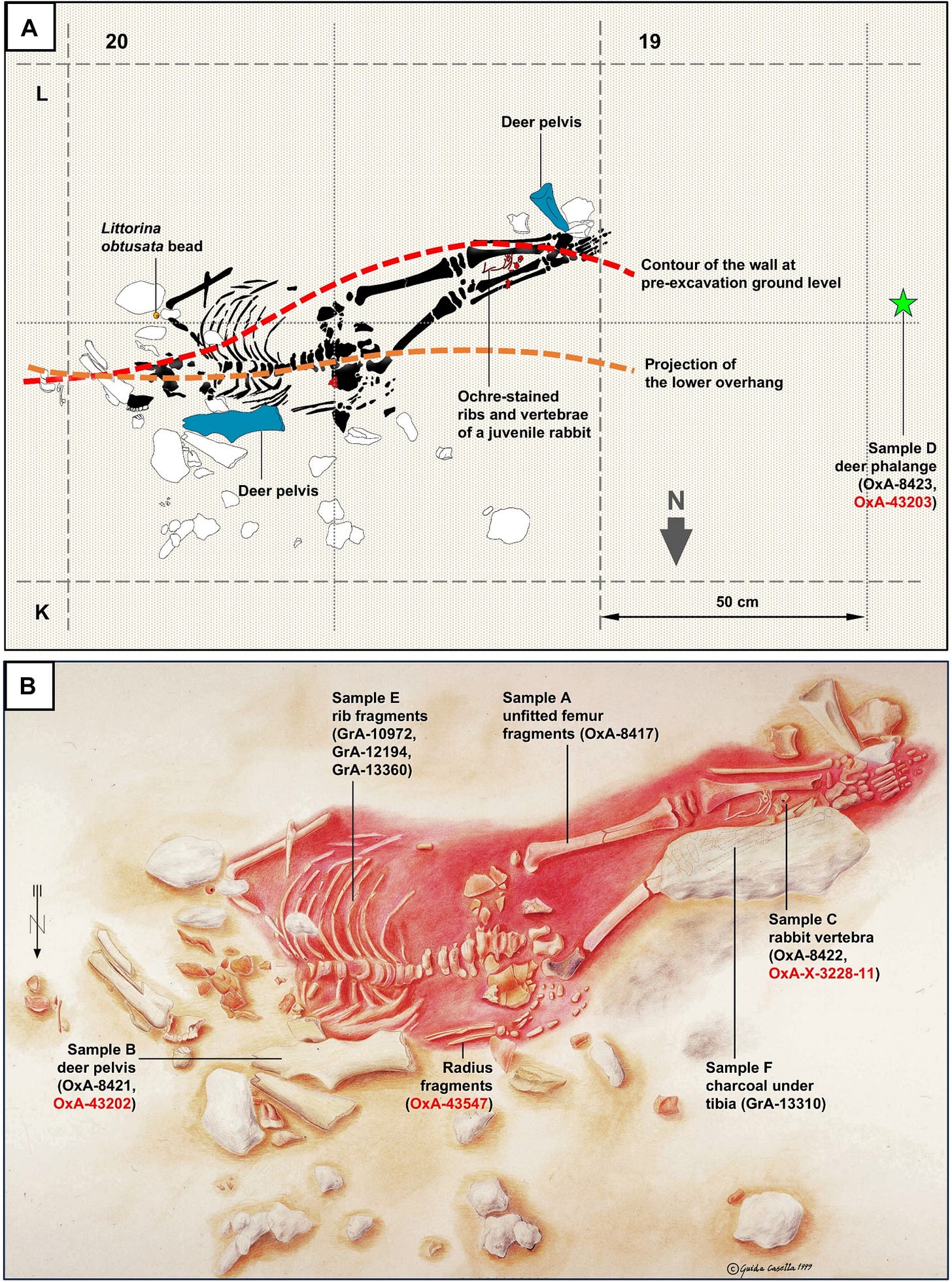Neanderthals And Humans Sitting In A Tree... 💋
The scientists were just proven wrong, we were still bumping and grinding with our distant cousins as late as 28,000 years ago.
Neanderthal didn't mysteriously die off 50,000 years ago. Pockets of them were still around and reproducing with humans over 20,000 years later than previously believed. We now have rock solid evidence, I’m referring to the find in central Portugal dubbed the "Lapedo Child," a fascinating archaeological discovery that has shed light on the interactions between Neanderthals and modern humans.
The remains of this individual were found in 1998 in the Lagar Velho rock shelter in the Lapedo Valley, central Portugal. This child, estimated to have been about 4 to 5 years old at the time of death, is notable for exhibiting a mix of Neanderthal and anatomically modern human (Homo sapiens) traits, suggesting it was a hybrid of the two groups.
Recent research, published in 2025, used advanced radiocarbon dating techniques—specifically compound-specific radiocarbon analysis (CSRA)—to determine that the Lapedo Child lived approximately 28,000 years ago, with a date range between 27,780 and 28,550 years ago. This timeline is significant because it places the child roughly 40,000 years after Neanderthals are traditionally thought to have gone extinct, around 40,000 years ago. This suggests either that Neanderthals persisted longer than previously believed or that their genetic legacy continued to appear in hybrid populations well after their disappearance as a distinct group.
The skeleton was discovered in a burial context, stained with red ochre and accompanied by items like rabbit bones, red deer bones, and charcoal, hinting at a ritualistic burial. The child’s physical features are a mix of characteristics: a prominent chin and human-like skull shape align with modern humans, while shorter, stockier legs and certain cranial traits resemble those of Neanderthals. This "mosaic" of features has been interpreted as evidence of interbreeding between Neanderthals and modern humans, a phenomenon now widely accepted thanks to genetic studies showing that many modern humans carry 1-2% Neanderthal DNA.
The dating of the Lapedo Child challenges earlier assumptions about the timing of Neanderthal extinction and their interactions with modern humans. While the conventional view holds that Neanderthals disappeared around 40,000 years ago, this find suggests either a longer survival in regions like Iberia or the persistence of Neanderthal traits in hybrid descendants. Unfortunately, no DNA has been successfully extracted from the Lapedo Child’s remains to confirm its hybrid status genetically, so the interpretation relies heavily on its skeletal morphology.
This discovery adds to the growing picture of human evolution as a complex web of interactions rather than a simple replacement of one species by another. It highlights how Neanderthals and modern humans coexisted and interbred, leaving traces that still echo in our genomes today.
When we consider the current narrative. .
Most scientists and scholars agree that roughly 50,000 years ago there was a brief period of Human / Neanderthal hybridization. This was immediately followed by the extinction of neanderthals who according to them, fully died off about 40,000 years ago.
This has several implications that are destroying the entire previous narrative. Plus there are several pieces of proof, well know to the scientific community that have been around for over twenty years. The biggest piece, is the fact that Aboriginal Australians are known as one of the highest Neanderthal, and Denisovan DNA bearing populations, and they made it to Australia over 60,000 years ago. Now we have the DNA of the Lepedo Child from roughly 28,000 years ago. These two finds are quite literally on the opposite sides of the world from each other. Meaning that this hybridization event was not brief or isolated, it lasted for roughly 48,000 years, and spanned most of the known world.
The real kicker, is that the Australian Natives got there on boats over 60,000 years ago, circa 58,000 BC. According to those same scientists and scholars, transoceanic travel was not possible until roughly 1,100 - 1,500 BC at the earliest.
Conclusion :
The “scholars” have either been disingenuous, knowing perfectly well for over two decades that none of this was true, or they have been working and promoting such compartmentalized views on these things, that they have no idea what their colleagues are doing on other digs. The latter makes too many assumptions, and is attributing to ignorance what can more easily be explained by malice.
Or maybe they really are just incompetent fucking boobs, either way millions of dollars have gone into funding answers to these damned questions, and whoever paid for them got robbed.
Links and Sources :
https://www.popularmechanics.com/science/archaeology/a64129388/human-neanderthal-hybrid/
https://www.livescience.com/archaeology/28-000-year-old-neanderthal-and-human-lapedo-child-lived-tens-of-thousands-of-years-after-our-closest-relatives-went-extinct
https://australian.museum/learn/science/human-evolution/homo-neanderthalensis/
https://www.independent.co.uk/news/science/archaeology/lapedo-child-neanderthals-human-lagar-velho-portugal-b2711466.html
https://thedebrief.org/breakthrough-radiocarbon-analysis-sheds-light-on-mysterious-human-neanderthal-hybrid-remains/
https://en.m.wikipedia.org/wiki/Lagar_Velho_1






